|
In 2009 I had another opportunity to lead a grain harvest/experiment. This time, one of my Spring Scythe Workshop participants had a field of oats that she had had planted on her land as a nurse crop for hay. She wanted to try to harvest some of it with a scythe. So we organized a workshop for it. The nice thing about having a grain harvest workshop with oats, was that we had a much greater window of opportunity in which to harvest the grain, compared to other grains. Oats don't fall off as easily, when ripe. This extended time-frame made it easier to schedule a workshop, and also to work around the weather. 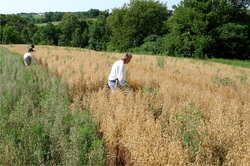 The workshop participants spread out along the long field, and each mowed a section of it.The oats had been mechanically planted with a drill. The stalks were very close together, but the rows were 5-6 inches apart. This made it difficult to mow a lot per stroke, in either direction; down the line of rows, or across the rows. We found it easiest to mow across the rows, so that we could deftly mow just one 5ft section of a row at a time, with each stroke of the scythe. The oats were so easy to mow this way, that they seemed to jump out of the way at the mere sight of the oncoming blade. With a little finesse, it was easy to keep all the heads falling to the right. And we could avoid mowing some of the weeds in between the rows. But we weren't able to mow a lot of volume per stroke this way. Since the oat rows were spaced by the drill, just far enough apart that it was hard to mow two or more rows at once, or to mow down the rows, with all the weeds in between. The field had been planted in non-organic corn, the year before. If it had been a dense, fertile, free-hand broadcasted stand of oats, such as in this Swedish video, I'm sure that it would have been a different story. But how to harvest the oats so that you have a sheave of actual oats, and not mostly lambsquarters, was the challenge. We didn't want to end up with sheaves that were filled with juicy green weeds. We thought it might make threshing more difficult, and we were worried about the green weeds not drying out properly and getting moldy. We tried out different strategies for mowing, and gathering up the grains. Some did all the mowing, and then came back and gathered up the cut stalks to form sheaves, some mowed enough for a sheave, and then gathered it up and tied it. Either way quickly became tedious. It wasn't long, before we all wished that grain cradles had been a part of the experiment. But alas none of us had one. Since we all had really good scythes, we felt very held back, like racehorses chomping at the bit. It would have been a lot more fun for us scythers, to have had a crew of 5 pickers following each one of us, forming and gathering the sheaves, and pulling out the green weeds. We would have enjoyed mowing more athletically, if we could have. The most tedious part of the experiment however was picking out all the big weeds out of the sheave before tying it. Especially the lambsquarters. There was tons of it in the field, and it was all tangled up in the oats. It also gave the insides of my bare arms a bad rash from holding the bundles of oat stalks, while pulling out the lambsquarters. 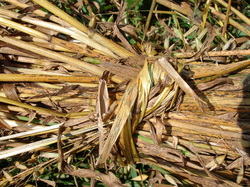 The oat straw itself worked great for tying the sheaves together. We used the method that is shown in the video below. We laid 5-8 stalks of oats together on the ground, and then laid handfuls of oat stalks perpendicular on top of it, with the heads all in one direction, until we had enough to form a sheave. Then we tied a knot by tightening the tie-straws, and twisting them together twice, and then tucking the twisted end under the band of straw. Very simple, quick, and effective. A well-made knot held very tight. When you thresh the sheave, it is very easy to pull the knot out. Threshing - Our spirits rose considerably when we took a break from the tedious task of harvesting in the hot sun, to try our hand at threshing. The farm we were at was constructing a small out-building. It was framed and had a plywood roof and floor. It was an ideal place to experiment with threshing. We brought up a garden cart load of sheaves, and laid them out in two rows with the heads touching in the center. I had made two flails for us to try out. I made them the handles out of 5 ft. long basswood, and the beater out of 18 inch long maple. I drilled holes horizontally through the ends, and tied them together with loops of Kevlar bootlaces. Rawhide works too. A more ideal flail can be seen at Wikipedia. First, we tried threshing with the sheaves still tied together. This didn't work so well. Next we tried untying the sheaves, and spreading the stalks out a little. To our delight, this was very effective. We were threshing grain! It worked! When threshing, it's not so much that you are trying to beat the grain off the heads heads, but rather that you are trying to thump them loose. You want to have the stalks spread out enough to form a layer, thick enough to be able to give the flail a good return bounce. When we pulled aside the straw, there was lots of loose oats on the floor. This we swept up with a broom and picked up with a big dust pan, and poured it into a 5 gallon bucket to winnow in the breeze. 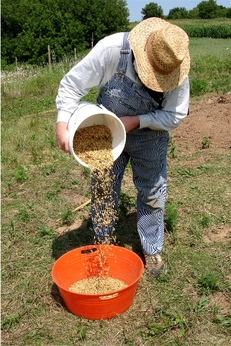 Winnowing - The winnowing worked great also. The farm was located on a high plateau, and there was a nice and steady breeze. I demonstrated pouring the grain from the 5 gallon bucket, into a wider tub. Most of the chaff fluttered away from the grain, on the very first pour. I wish that I had a picture of that. As the other workshop participants gave it a try, it was already pretty clean. Seeing all those clean oats put beaming smiles on all our faces. To top off our festive mood, a relative of the farmer showed up, and a Birthday cake was brought out, and we all shared in the celebration. Good food always seems to show up at scythe workshops. The workshop was a success. The owner was happy to have some homegrown grain to feed her chickens and goats. I left her one of my flails to continue threshing the rest.
2 Comments
ANIL SAWHNEY
5/7/2011 12:56:20 pm
Could you please explain the method of removing the husk from the Oats seed to bring out unpolished oats!
Reply
5/15/2015 01:53:47 am
Hulled oats on a homescale, are now mostly used for animal feed. To remove the hull takes special milling equipment, that is not available on a home-scale anymore. If you want to grow oats for people food, try a hulless variety.
Reply
Your comment will be posted after it is approved.
Leave a Reply. |
Botan AndersonArchives
March 2023
Categories
All
|
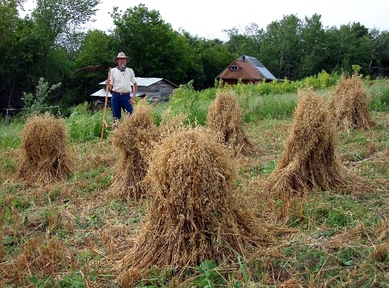
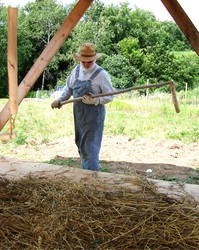
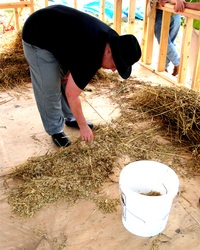
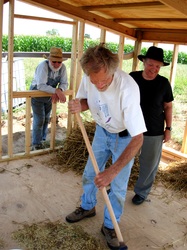
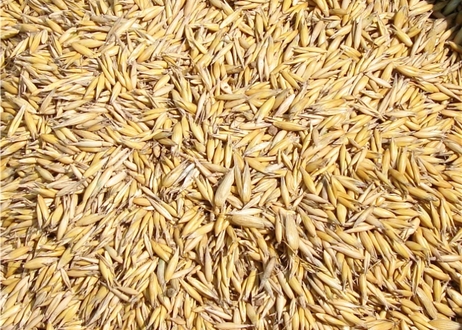
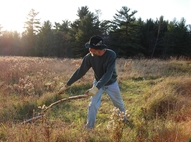
 RSS Feed
RSS Feed